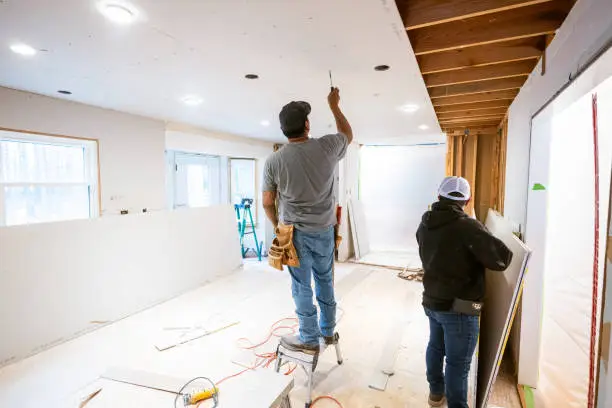A DIY drywall installation saves money on labor costs but requires significant time, effort, and potential for mistakes. Professional drywall installation ensures quality, efficiency, and a better return on investment for larger jobs or when specialized skills are needed, but it comes at a higher upfront cost. Understanding the pros and cons of DIY vs. professional installation is essential to make the right choice for your budget, based on your skill level. GOOD SAMARITAN SERVICES LLC has the unparalleled expertise in providing drywall installation, ensuring a flawless finish each time.
When to Trust Pros and When to Go DIY? Decoding the Drywall Installation Dilemma
Do you have a knack for fixing everything, and are you thinking about tackling your drywall installation yourself? DIY drywall installation can save money and offer a sense of accomplishment, but it requires time, dedication, and skills. While drywall installation is relatively quick and affordable, it also presents challenges related to water damage and the need for specialized tools and techniques. Professionals offer speed, expertise, and a guarantee of quality, especially for intricate work, but it comes at a higher cost. The best approach depends on your budget, skill level, and the project’s complexity.
Is DIY drywall installation worth the risk? Here are the hidden tradeoffs when exploring the true cost of forgetting the professionals.

DIY Dilemma of Drywall Installation
Pros:
- Cost savings
DIY drywall installations can be significantly cheaper as you avoid the labor costs, which make up a substantial portion of the total expense.
- Flexibility and control
With DIY, you have more control over the pace and the schedule of the project, allowing you to work at your own speed.
- Sense of accomplishment
Completing a DIY project can be satisfying and a great learning opportunity.
Cons:
- Time consuming
DIY drywall installations can take much longer than professional installations, especially if you’re not experienced.
- Risk of mistakes
Errors like improper taping, mudding, patching, or sanding can lead to uneven finishes, peeling paint, or other issues, requiring rework and may end up in uneven seams and textures.
- Safety concerns
Lifting the large drywall sheets can be a safety hazard. Installation involves working with tools and equipment that can be hazardous, including electrical wiring and debris.
- Requires learning and specialized tools
For successful DIY drywall installation, you’ll need to learn proper techniques and require specific tools not easily available for an average homeowner.
- Can be physically demanding
Lifting and maneuvering large drywall sheets can be challenging and your DIY endeavor, instead of a cost-saving endeavor, can turn into a frustrating mess if you don’t have the skills for it.

| Did you know? Recent studies have highlighted the prevalence of musculoskeletal injuries in drywall installers due to over-exertion (37%) and falls (32%), with lifting, carrying, and holding drywall sheets being major contributing factors, emphasizing the need for ergonomic improvements in the installation process. |
Professional Drywall Installation
Pros:
- Quality and efficiency
Professionals have the experience and the expertise to ensure a smooth and even finish, minimizing the risk of future issues.
- Time savings
Professionals can finish a project much faster than DIYers and save you the time and hassle to focus on other aspects of the project.
- Expertise in complex projects
Professionals are well-equipped to handle intricate designs, textured finishes, and challenging installations.
- Potential for better materials
Professional contractors have access to better deals on materials, saving you money on the overall project.
| Interesting Fact: Drywall sheets vary by thickness and weight. Some weigh less than 55 pounds, while others weigh more than 120 pounds. |
Cons:
- Higher cost
Professional work involves paying for labor, which can significantly increase the project’s cost.
- Less control
You may have less control over the pace and schedule of the project.
- Dependence on contractor availability
You’ll need to coordinate with the professional’s schedule for the completion of your project.
Conclusion
A small DIY drywall installation project can be a rewarding experience, but larger, more complex jobs should best be left to the professionals. You need to consider your budget, skill level, time constraints, and the complexity of the project when deciding between DIY vs. Professional drywall installation. DIY projects may save money on labor, but can cost you in terms of time, effort, and the quality of the finished project. Professional installations are more expensive upfront but result in a beautiful finish and peace of mind.
FAQs
What is the history of drywall?
Drywall was invented in 1916 as a dry alternative to plaster. Homes and buildings constructed using drywall could be completed in 1/10th of the time versus using plaster.
Why is it called drywall?
The name refers to the fact that walls made of this material are installed without the use of water.
What are the benefits of drywall installation?
Some of the benefits of drywall include fire resistance, affordability, and its soundproofing capabilities.
What’s the average cost per square foot for professional drywall installation today?
Professional drywall installation—including materials, hanging, taping, mudding, and finishing—typically costs between $1.50 and $3.50 per square foot. For ceilings, the cost can rise slightly to $1.50–$3.80 per square foot.
What are the injury risks associated with drywall work that DIYers should watch out for?
Drywall installation can pose significant ergonomic hazards. Lifting heavy sheets, maintaining awkward postures, and repetitive motions (e.g., sanding or taping) are common culprits. In construction, back injuries are 50% more common than in other industries, and workers often experience pain in the back, shoulders, neck, and arms
